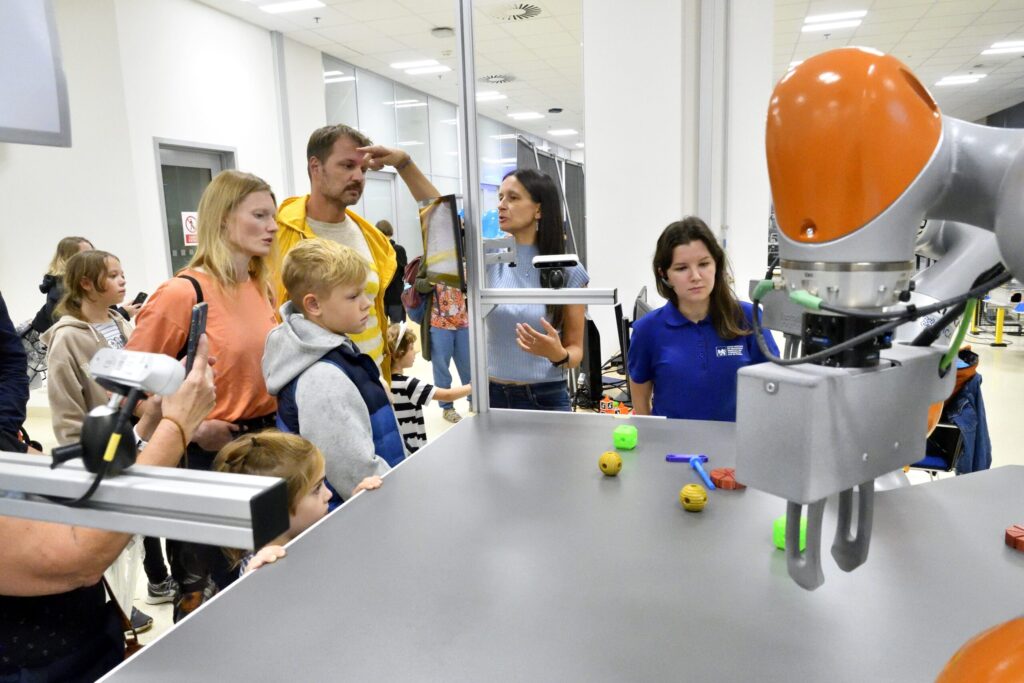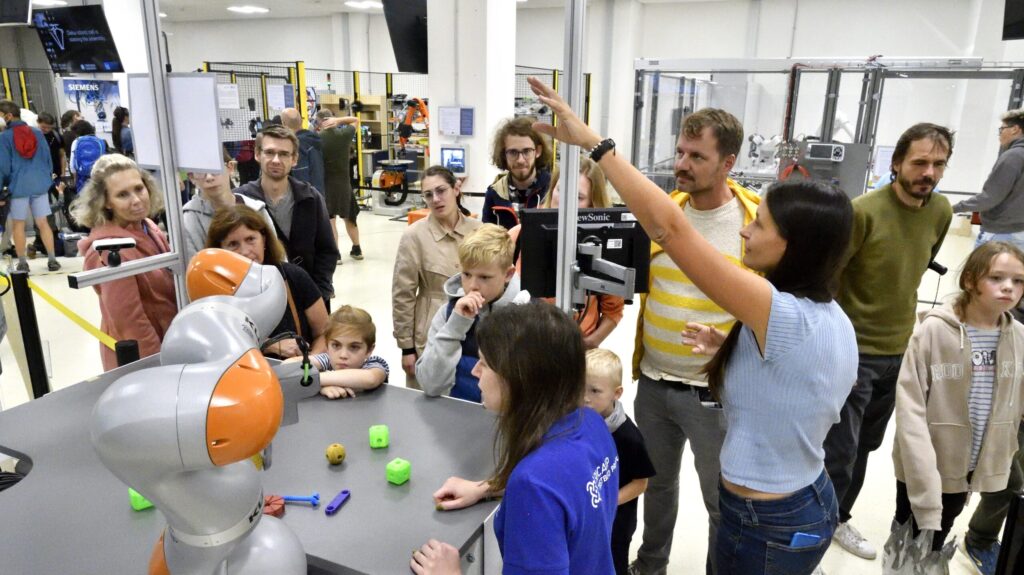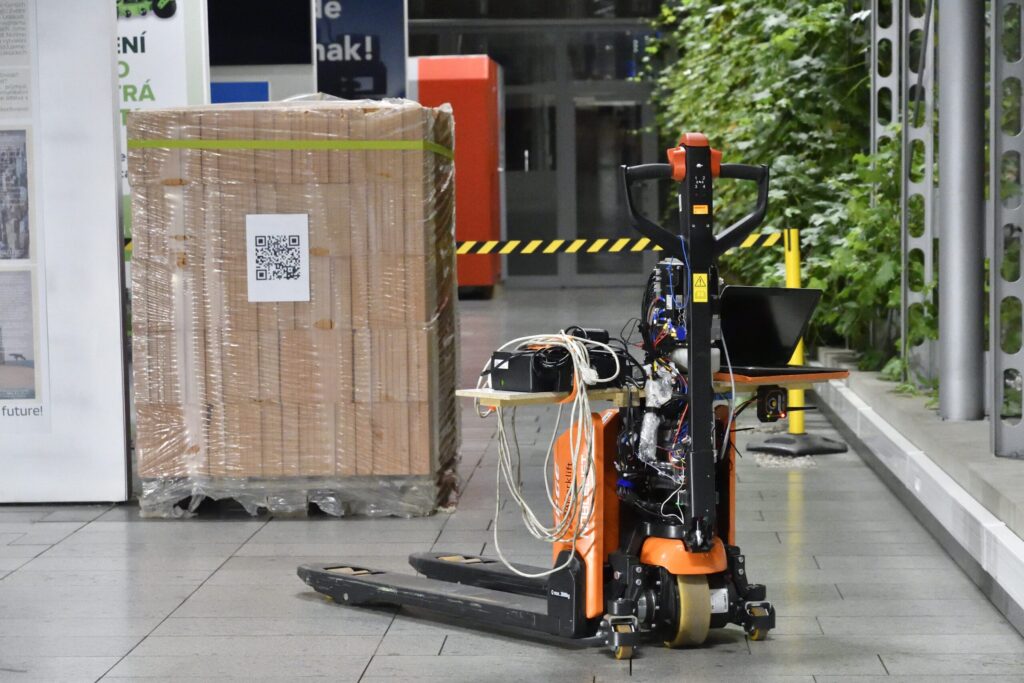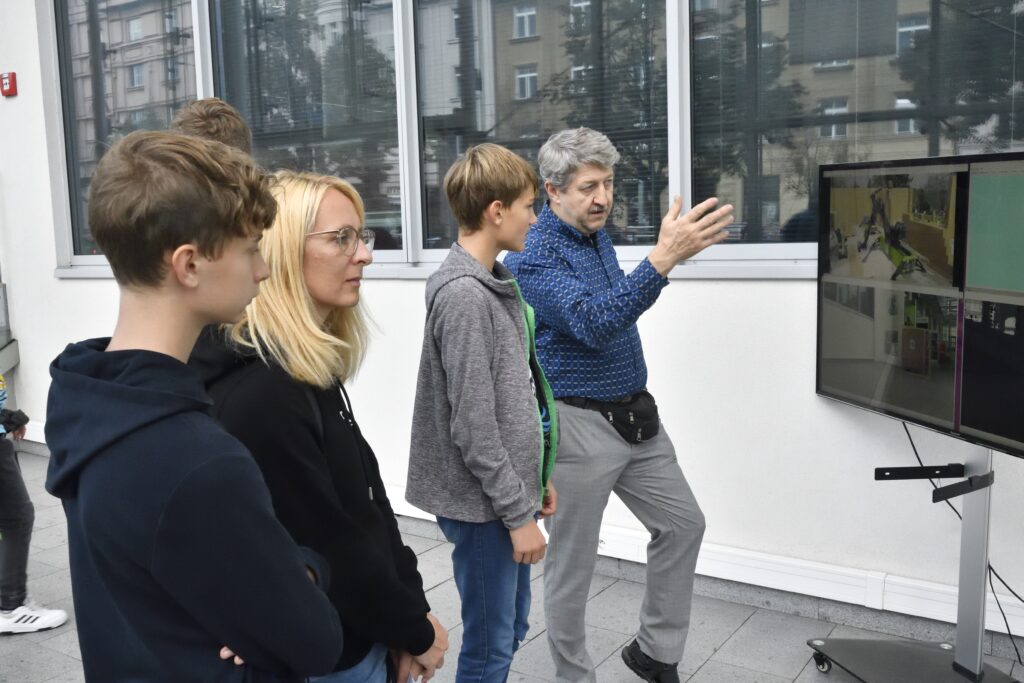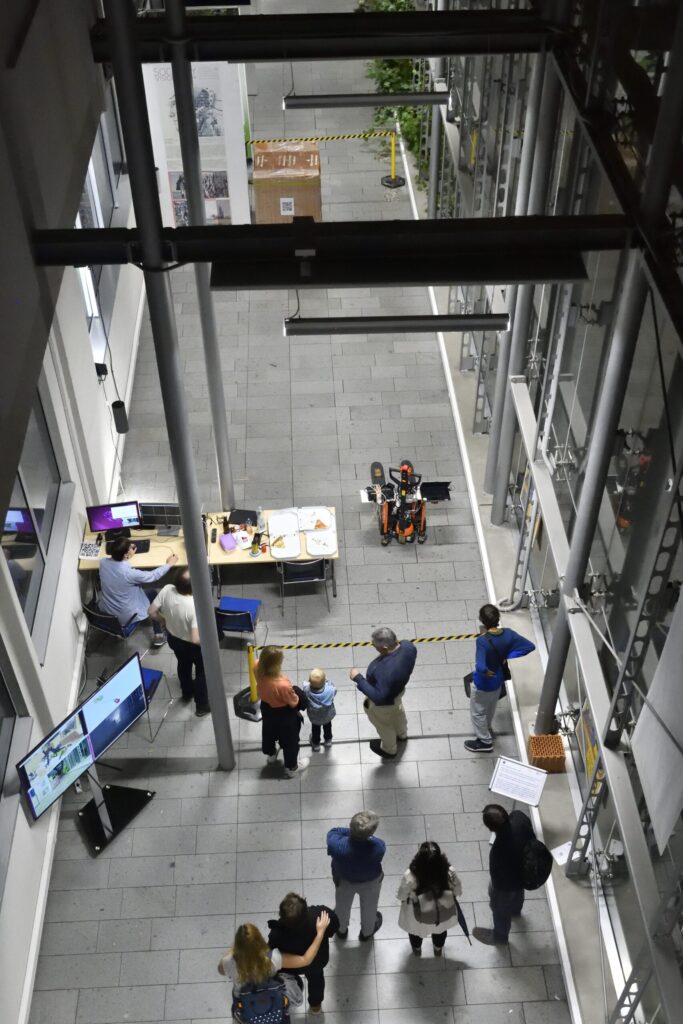Keynote talk at Cognition and Artificial Life, Slovakia
22.5.2025
Karla Stepanova had a keynote talk at the conference Cognition and Artificial Life in Slovakia.
As robotics continues to expand into dynamic and small-batch production settings, the need for intuitive and flexible task specification is becoming increasingly important. This talk presents a novel approach to natural task specification, enabling rapid task definition and deployment without the burden of extensive programming. By integrating human demonstrations, language, and gestures, we create more accessible and adaptable ways to define task parameters and constraints. Additionally, we explore robust task representation methods that structure these specifications for easy transfer across different robotic setups and enable fluent transformation into executable robot plans. This approach also enhances adaptability to new environments and represents a significant step toward more human-centric, flexible robotic systems—bringing us closer to truly natural collaborative automation.
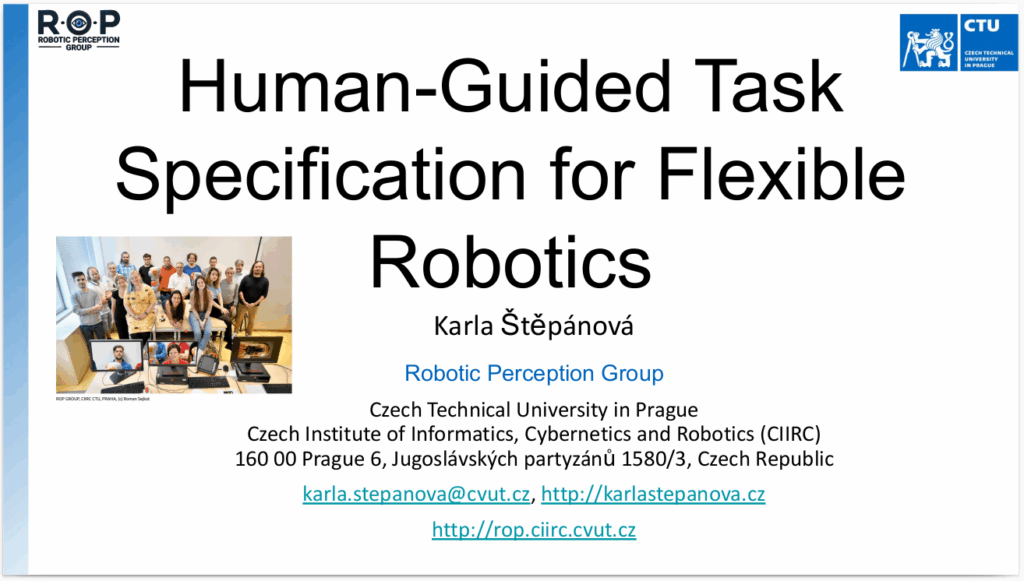
📄 Slides: KUZ 2025 – Task specification for flexible robotics – PDF slides
Conference website: KUZ/CAL 2025
Gabriela Šejnová defended her PhD thesis!
6.5.2025
Her thesis “Multimodal variational autoencoder for instruction-based robotic action generation” can be found here
Scholar profile: link
Some of her most relevant papers:
- Bridging Language, Vision and Action: Multimodal VAEs in Robotic Manipulation Tasks (IROS 2024) –
- Imitrob: Imitation Learning Dataset for Training and Evaluating 6D Object Pose Estimators (RAL 2023)
- Feedback-Driven Incremental Imitation Learning Using Sequential VAE (ICDL 2022)
- Reward Redistribution for Reinforcement Learning of Dynamic Nonprehensile Manipulation (ICARR, 2021)
- Exploring logical consistency and viewport sensitivity in compositional VQA models (IROS 2019)
Martin Matoušek Presented at the KRF 2025 Conference
At the 13th Conference on Radiological Physics, held April 8–10, 2025, in Srní, Czech Republic, Martin Matoušek delivered a presentation titled “Tool for Automatic Evaluation of Radiographic Calibration Phantom Images”, co-authored with Václav Hlaváč. Presenting their work from EDIH CTU project in cooperation with Motol Hospital
The presented tool leverages methods from digital image processing and computer vision to perform automatic quantitative analysis of radiographic calibration phantoms. It supports visual inspection of results, generates exportable XLS reports including measurements and graphs, and offers user-friendly outputs to assist operators during image evaluation. Originally developed for the Department of Medical Physics at FN Motol, the tool holds potential for adaptation to other phantom types.

🔗 More about the conference: csfm.cz – Conference 2025
Slides (in Czech): KRF 2025 talk – pdf (CZ)
Marina Ionova’s Diploma Thesis Wins Werner von Siemens Prize
20.3.2025
Marina Ionova’s master’s thesis has been honored with both the Werner von Siemens Prize for the Best Master Thesis in Industry 4.0 and the Special Jury Award for Outstanding Quality of Female Scientific Work.
Under the supervision of Dr. Jan Kristof Behrens from our Robotic Perception Group, Marina tackled one of the most intricate challenges in modern manufacturing: achieving truly seamless collaboration between humans and robots in dynamic production settings. By combining constraint‑based programming with behavior trees, her approach skillfully handles the uncertainty and non‑deterministic nature of human actions, paving the way for more adaptable and intuitive human‑robot teamwork on the factory floor.
We extend our heartfelt congratulations to Marina for this outstanding achievement and are proud that our group’s mentorship contributed to such impactful, forward‑thinking research.
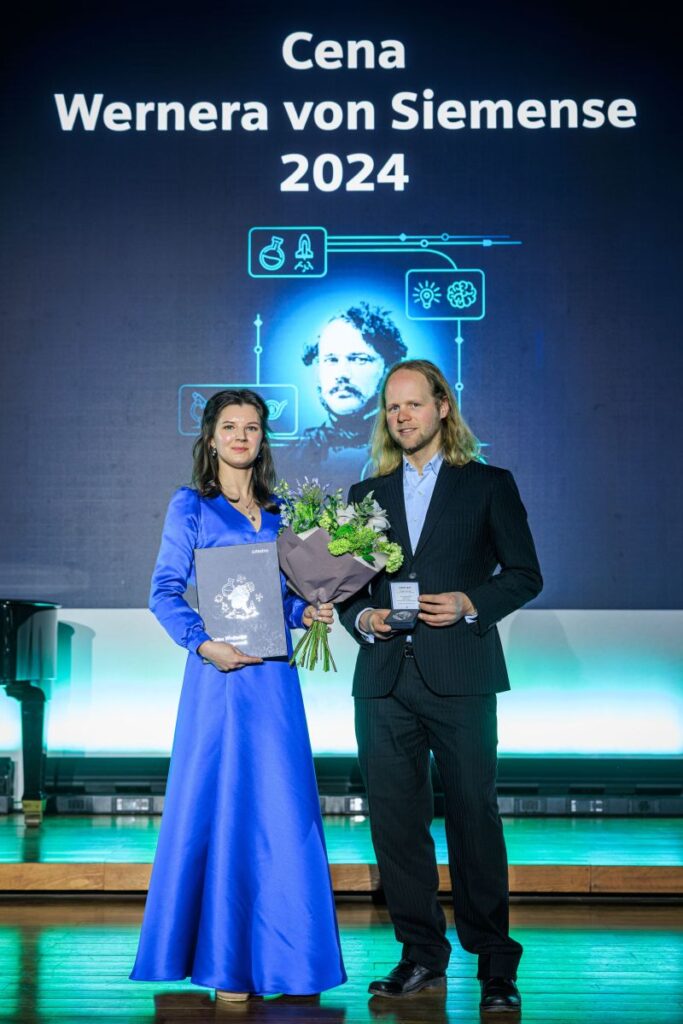
Finished Industrial Project: Automated Trajectory Planning for Robotic Plastic Tank Welding
13. 3. 2025
Our Robotic Perception Group has successfully completed an industrial project focused on automating trajectory planning for a robotic welding cell used in plastic tank production. The project addressed a key bottleneck in small-batch manufacturing, where manual trajectory programming for each setup is inefficient and costly. By automating the process, our system generates an optimized robot trajectory based on: 1) A digital model of the welding cell, 2) The tank to be welded, and 3)The specified weld seams
With 9 degrees of freedom, trajectory planning becomes a complex optimization problem with multiple constraints. Our solution enables flexible, efficient deployment without manual intervention.
Team: Vladimír Smutný (lead), Pavel Krsek, Matěj Vetchý, Tomáš Fiala, and others.
Our Partners include TAČR project (2021–2023): ALAD CZ, triotec s.r.o., and STP plast. This project was supported by the Technologická agentura ČR and EDIH CTU.
Two Papers from Our Group Accepted to ICRA 2025 and RAL
12.2.2025
We’re proud to announce that two papers from our Robotics Perception Group have been accepted for presentation at ICRA 2025, with one also published in the RAL journal.
📅 Catch both presentations at ICRA 2025, May 19–23 in Atlanta, GA. We look forward to sharing our work and connecting with the robotics community!
📄Closed-loop Interactive Embodied Resoning for Robot manipulation
In collaboration with Imperial College London, this work explores how robots can dynamically adapt their actions using interactive perception (e.g., weighing, measuring stiffness) and neurosymbolic AI. Robots adjust at three levels—physical, action, and knowledge—based on real-time feedback during manipulation.
🤖 Authors: Michał Nazarczuk, Jan Behrens, Karla Štěpánová, Matej Hoffmann, Krystian Mikolajczyk
More about the paper: https://lnkd.in/ea2bgNiJ
🔗 Learn more:
🔗 ArXiv: https://lnkd.in/eksYzx-b
🌐 Project website https://lnkd.in/e9R5tgjj
📽️ YouTube video: https://lnkd.in/e2UB7BZs
🤖 In this work, we explore how robots can continuously refine their actions while executing a task, dynamically adapting to new information utilizing 𝗻𝗲𝘂𝗿𝗼𝘀𝘆𝗺𝗯𝗼𝗹𝗶𝗰 𝗔𝗜 𝗶𝗻 𝗰𝗼𝗺𝗯𝗶𝗻𝗮𝘁𝗶𝗼𝗻 𝘄𝗶𝘁𝗵 𝗶𝗻𝘁𝗲𝗿𝗮𝗰𝘁𝗶𝘃𝗲 𝗽𝗲𝗿𝗰𝗲𝗽𝘁𝗶𝗼𝗻 (e.g., weighing, measuring stiffness, etc.).
During task execution, our robot adjusts its actions based on feedback at three levels:
1️⃣ Physical level – If the object moves while the robot is grasping it, the trajectory must be adjusted.
2️⃣ Action level – If part of an assembly is disassembled, the robot must replan to achieve the goal.
3️⃣ Knowledge level – The robot updates its plan based on new observations (e.g., learning an object’s weight).
This is work with Michał Nazarczuk, Jan Behrens, Karla Štěpánová, Matej Hoffmann and Krystian Mikolajczyk
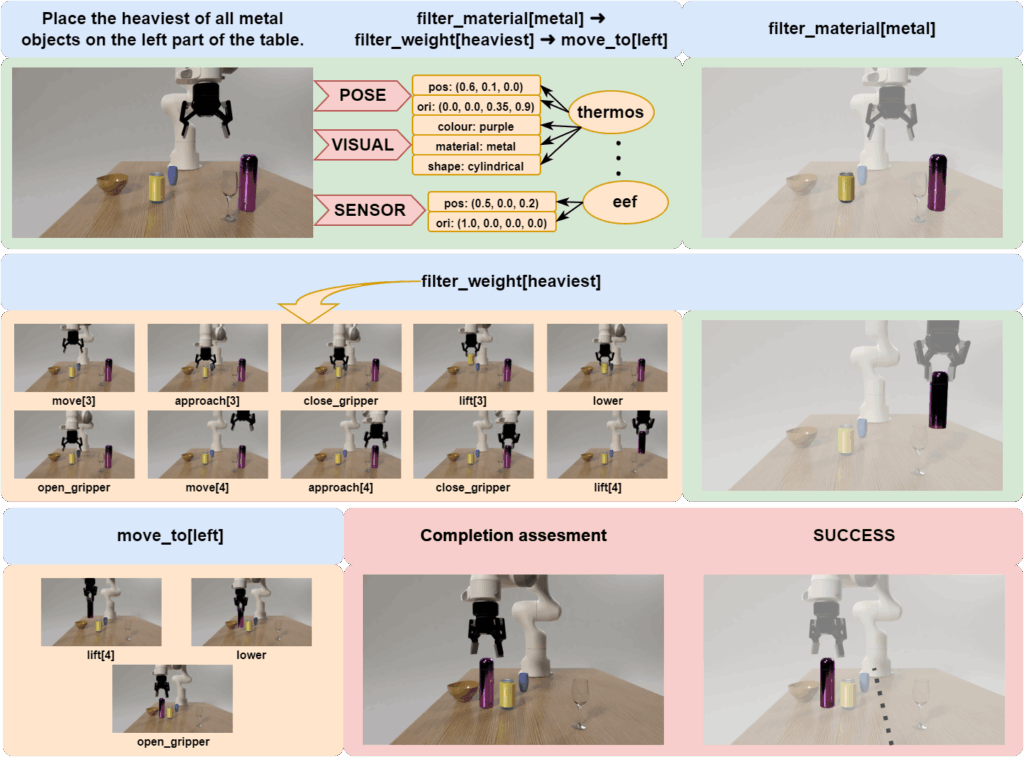
Authors: Michał Nazarczuk, Jan Behrens, Karla Štěpánová, Matej Hoffmann, Krystian Mikolajczyk
🔗 ArXiv | Project Website | YouTube Demo
📄MovingCables: Moving Cable Segmentation method and dataset
🤖 Authors: Ondrej Holesovsky, Radoslav Škoviera, Vaclav Hlavac
📘 Published in: IEEE Robotics and Automation Letters (RAL) – [PDF from IEEE]
🗓️ Thursday, May 22, 2025
⏰ 16:55 – 17:00
📍 Paper ThET15.5, Datasets and Benchmarking session
O. Holešovský, R. Škoviera and V. Hlaváč, “MovingCables: Moving Cable Segmentation Method and Dataset,” in IEEE Robotics and Automation Letters, vol. 9, no. 8, pp. 6991-6998, Aug. 2024, doi: 10.1109/LRA.2024.3416800.
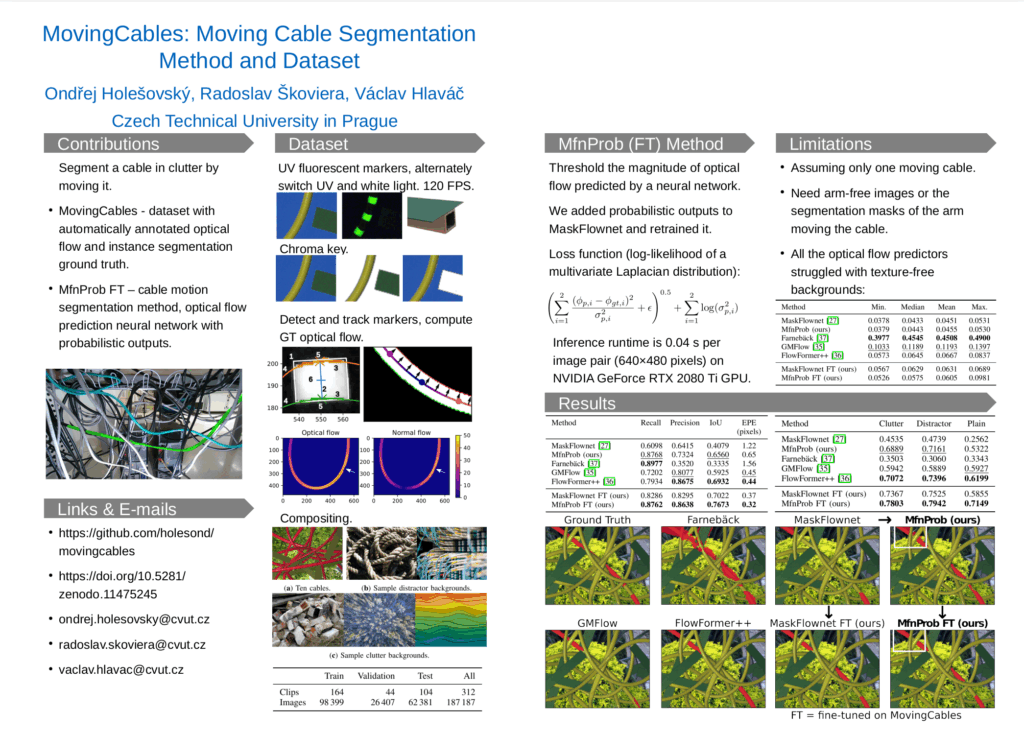
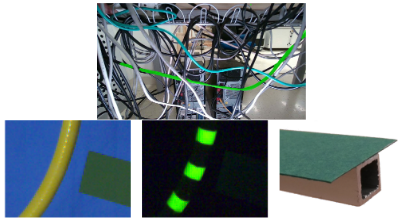
Presentation for students from Charles university
8.1.2025
An interesting discussion on the ethical aspects of AI and autonomous robotics arose during our recent demo for students from Charles University. One particularly thought-provoking question explored whether affordable humanoid robots might soon be available for household use, amateur development, and the broader implications this might have for robotics in the context of widespread adoption of LLM, VLM, and VLA models.
Other questions delved into autonomous cars and the types of errors they might encounter, why Elon Musk insisted on using only visual sensors in Teslas, or the diverse applications for gesture-based robotics (research focus of our PhD student Petr Vanc) that range from operating in environments inaccessible due to radiation or stringent hygiene standards, to long-distance communication like controlling drones from the ground, and even to household robots and natural human-robot interaction.
Welcoming students from the Faculty of Humanities at Charles University, as part of their course “Artificial Intelligence from the Perspective of Humanities,” was truly a pleasure. I’m happy that our Ph.D. student, Karina Zamrazilová, who teaches this course, had the great idea of hosting one of their lessons at our institute.
Connecting people from diverse fields is a key part of our group’s philosophy. Interesting research questions often arise at the intersection of disciplines when we step outside the confines of a single perspective.
If you’re curious about what we do in our group and would like to try some of our demos—such as operating a robot through gestures or language, conducting an robotic experiment in VR, or exploring our more industrial activities like brick-laying robot—don’t hesitate to reach out. We’d be happy to arrange something for you!
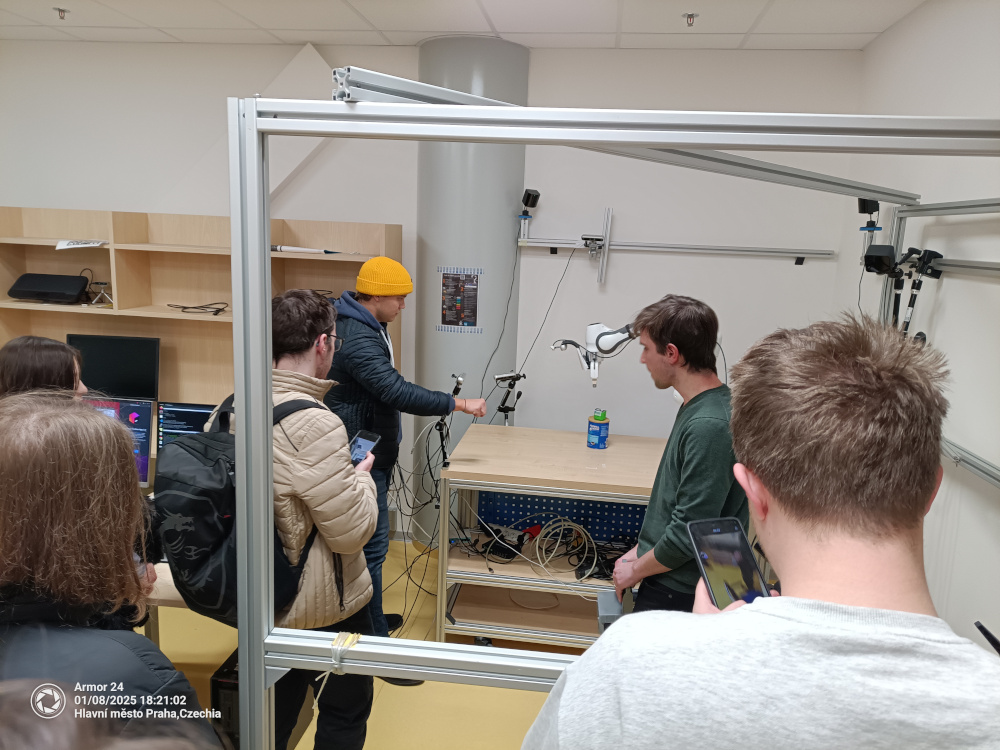
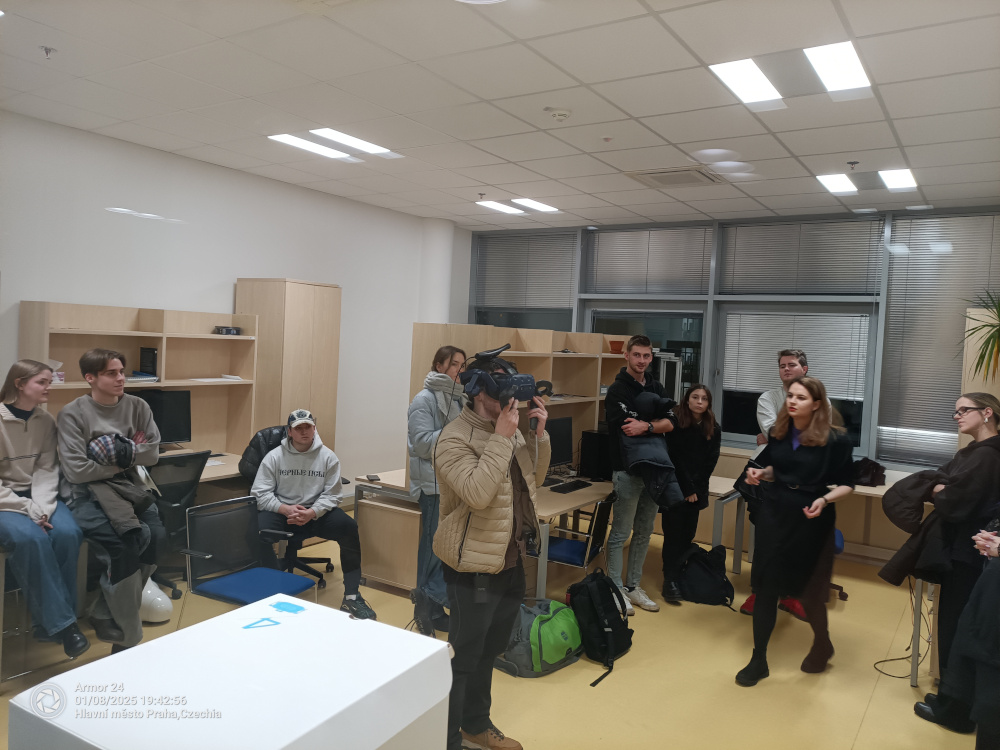
Esej in Academix revue by prof.Hlaváč
6.1.2025
An essay by Prof. Vaclav Hlavac on the challenges of visual perception in robotics can be found in the current issue (4/2024) of Academix Revue (in Czech), along with several other texts from members of our institute.
How about you? Do you find opportunities to share your work with broader audiences?
How often do you write for the general public? What benefits do you see in it?
Publishing not only for the scientific community but also for the general public should be an essential task for every researcher. While it may not directly contribute to their h-index, it often has a far greater impact on society as a whole.

XMas party of the group
18.12.2024
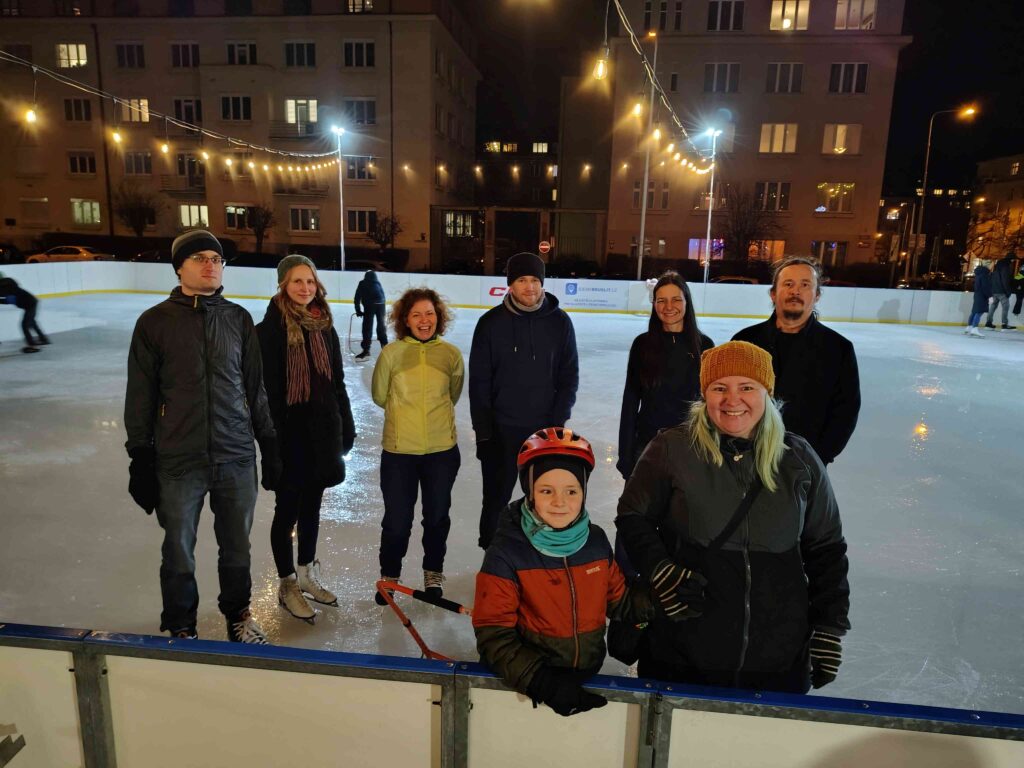
Visit of a group from MIAS CTU (future technical economs)
13.12.2024
We had a nice visit of a group from MIAS CTU (Masaryk institute of advanced studies, future technical economs) within the subject Introduction to robotics led by prof.Stepankova. They came to see our human-robot collaboration setup.
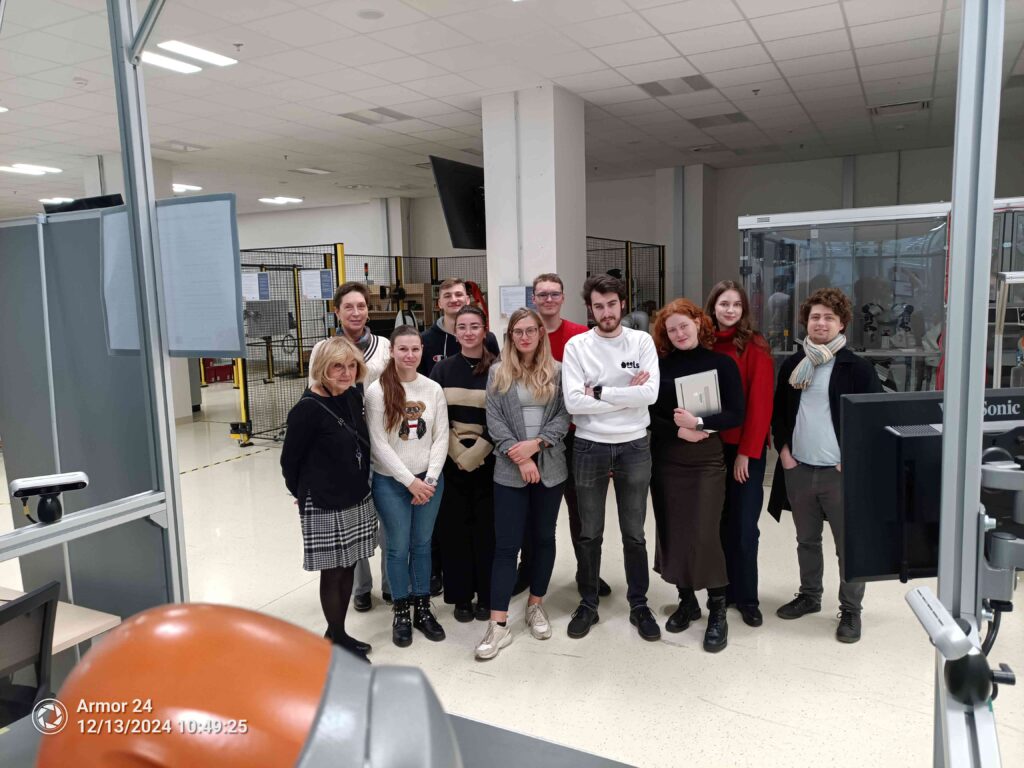
Our robots at Czech TV – Wifina
25.11.2024
Our robots were presented by Karla Stepanova, Petr Vanc and Libor Wagner for kids programme Wifina at Czech TV. Kuba who visited us tried to teleoperate the robot similarly to how surgeons do it. He also tried to operate it just by gestures.
Are you also interested why we call our robots “panda” or “capek”?
Or how are robots listening to us?
You can see the video online from 2:30 here: Wifina – 27.11.2024

ATHENS Programme Students Visit at ROP, CTU CIIRC
22. 11. 2024
Students from the ATHENS Programme (organized by Prof. Procházka) recently visited our group as part of their trip to the Czech Technical University’s Czech Institute of Informatics, Robotics, and Cybernetics (CIIRC). The event featured presentations that connected theoretical concepts with significant practical applications in computational intelligence. The students toured three laboratories: the Intelligent and Mobile Robotics Group, the Big Data and Cloud Computing Lab, and our Robotics Perception Group. We showcased our collaborative human-robot workplace, force-torque compliant robots, and an automated palletizer for a brick-laying robot. Participants appreciated the experience, finding it motivating for their future studies.
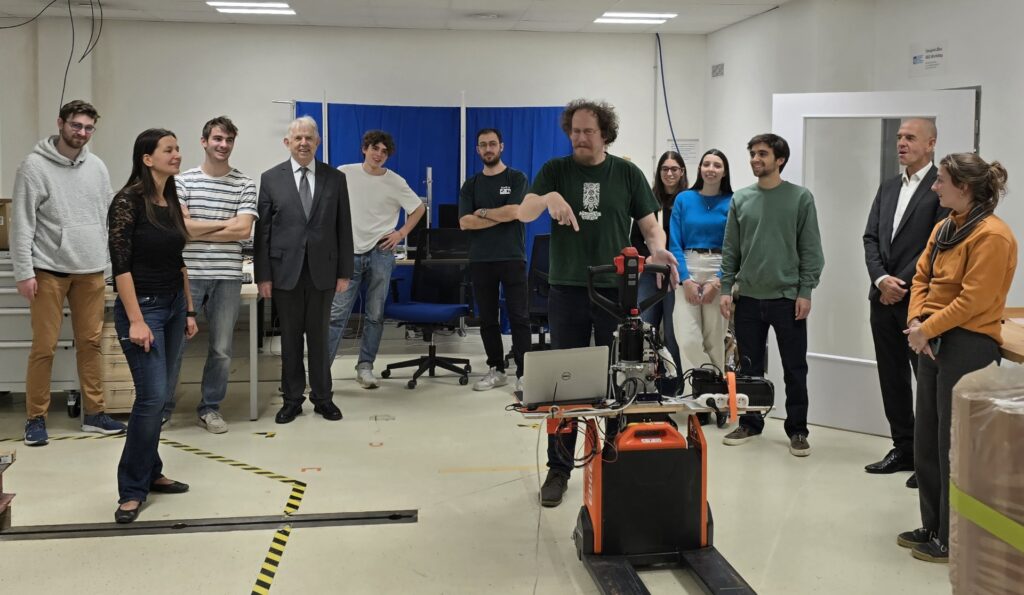
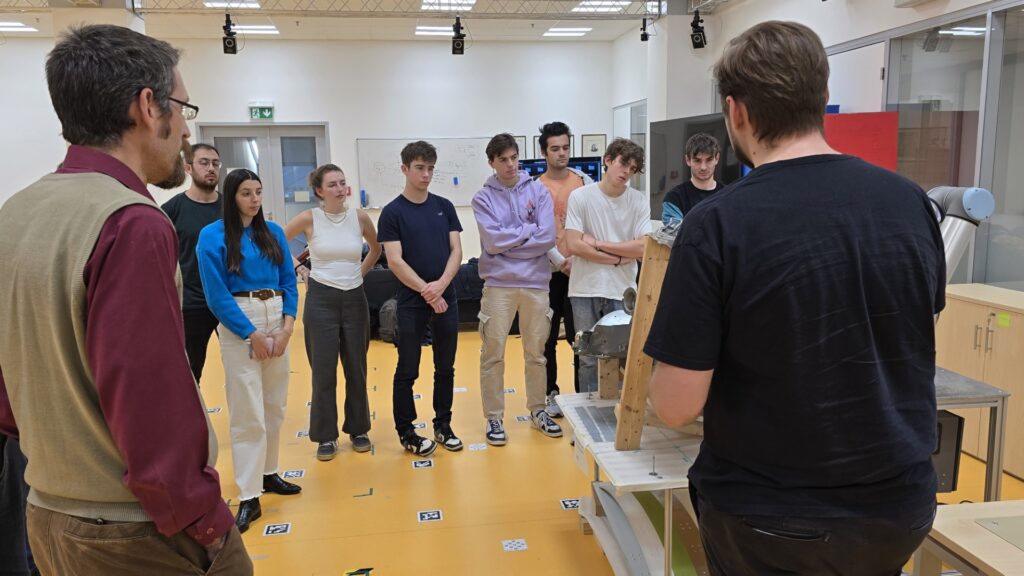
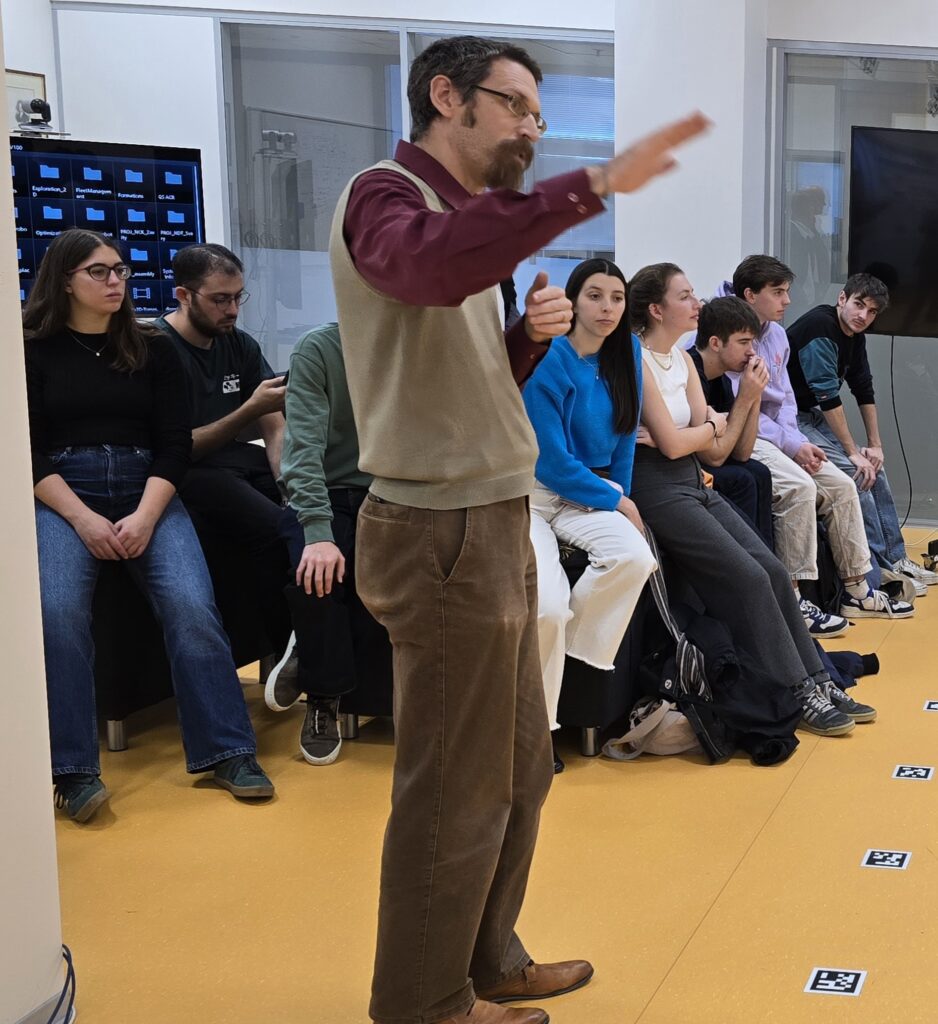
IROS 2024 – Abu Dhabi
18. 10. 2024
This year we presented at IROS in Abu Dhabi (14.-18.10.2024) two scientific papers from our group.
Scientific paper entitled „Bridging Language, Vision and Action: Multimodal VAEs in Robotic Manipulation Tasks“ by Gabriela Šejnová, Karla Štěpánová and Michal Vavrečka addresses a key topic in the development of intelligent autonomous robots. The researchers focus on how to teach robots to perform complex manipulation tasks based on language commands, visual perception and demonstrated movements. The goal of the research is to achieve a higher level of autonomy for robots that can recognise different objects and perform new tasks with them based on linguistic instructions, without the need for pre-programming. Article about the paper: CIIRC web. Full article here: ArXiv, Video.


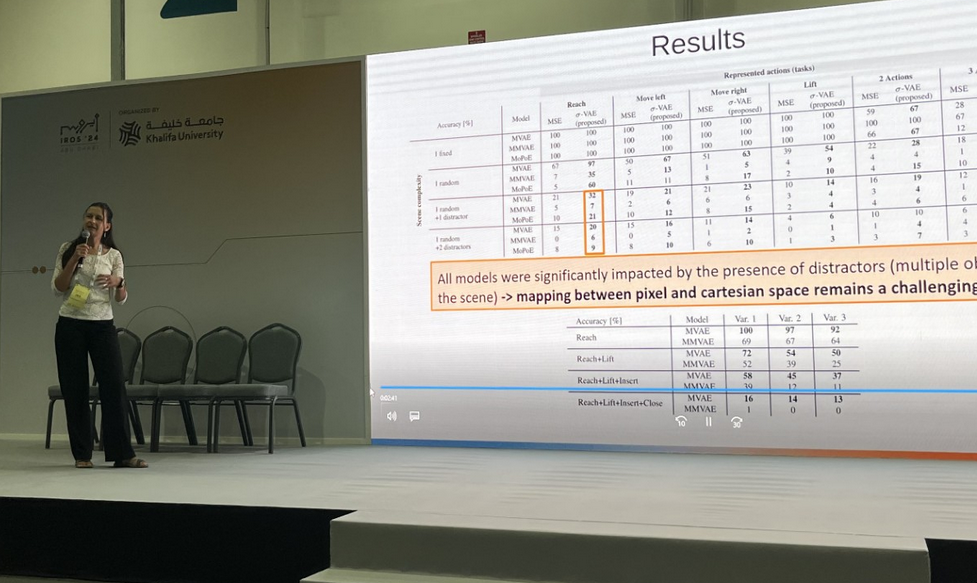
Second paper entitled CoBOS: Constraint-Based Online Scheduler for Human-Robot Collaboration by Marina Ionova and Jan Kristof Behrens proposes a novel approach of online constraint-based scheduling of tasks between human and robot. The reactive execution control framework facilitates behavior trees and is called CoBOS. It allows the robot to adapt to uncertain events such as delayed activity completions and activity selection (by the human). Full article here: ArXiv, youtube.

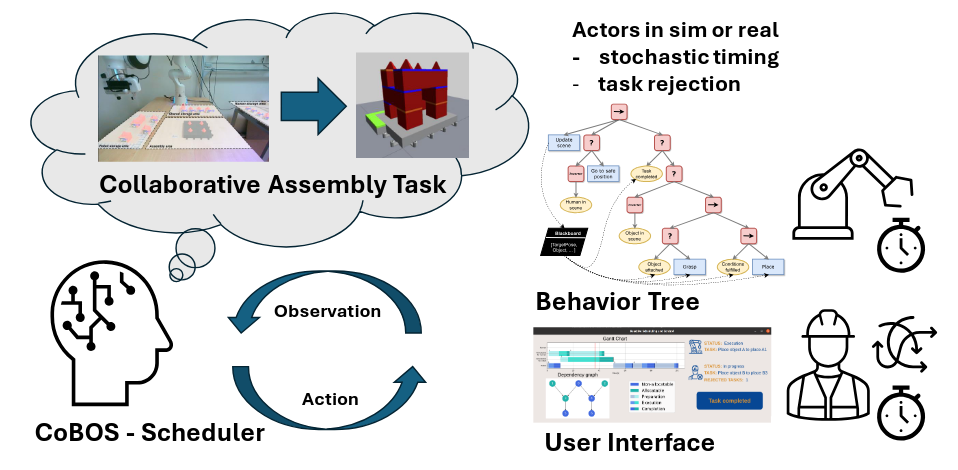
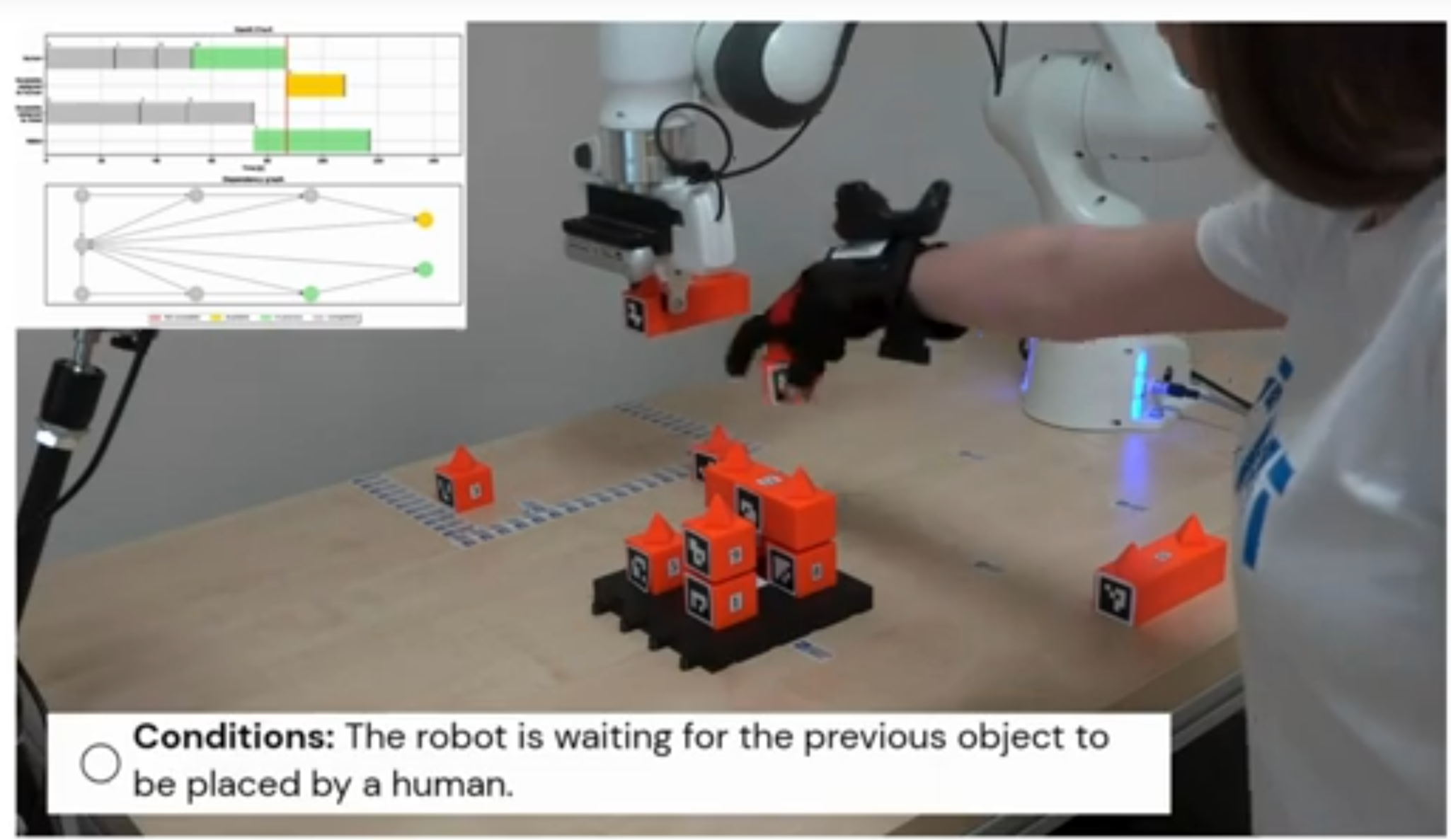
Researcher’s night 2024
27. 9. 2024
Our group took part in Researcher’s night. Vladimir Smutny, Pavel Krsek and Mira Uller presented their automated palletizer and Rado Skoviera and Karla Stepanova the human-robot collaboration workplace. Both of the presentations were very successful. Only issue was that after transferring microphone between individual people it got soon broken so we could not let kids command the robot by themselves. But they still had a lot of fun.
